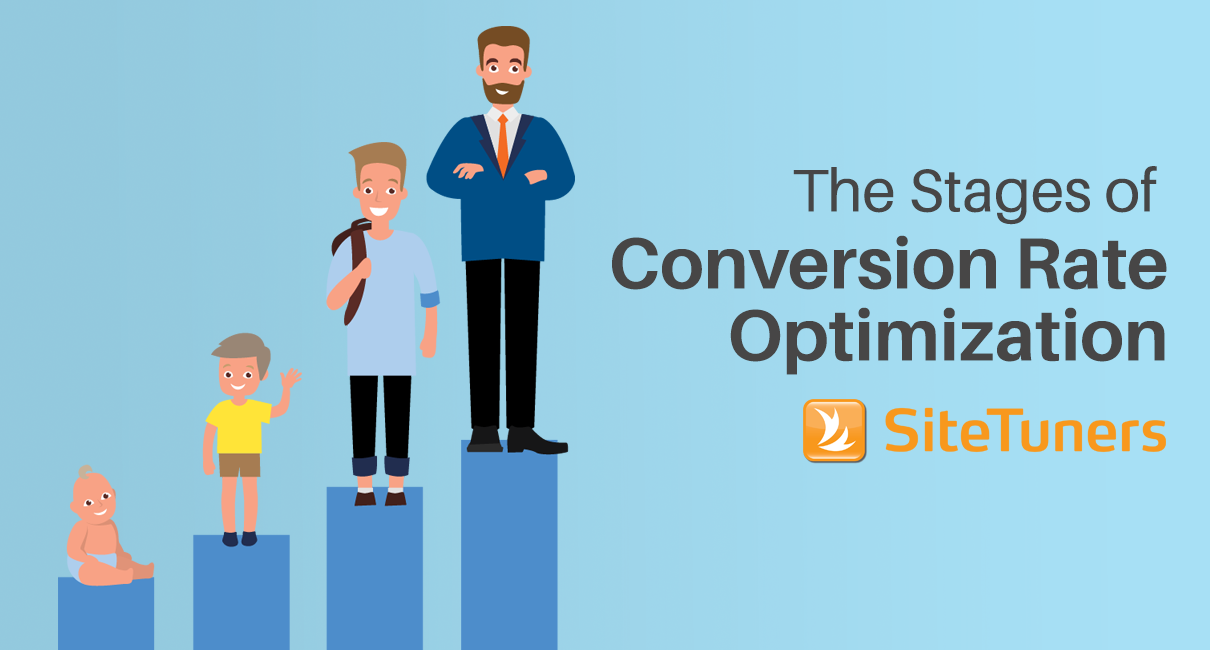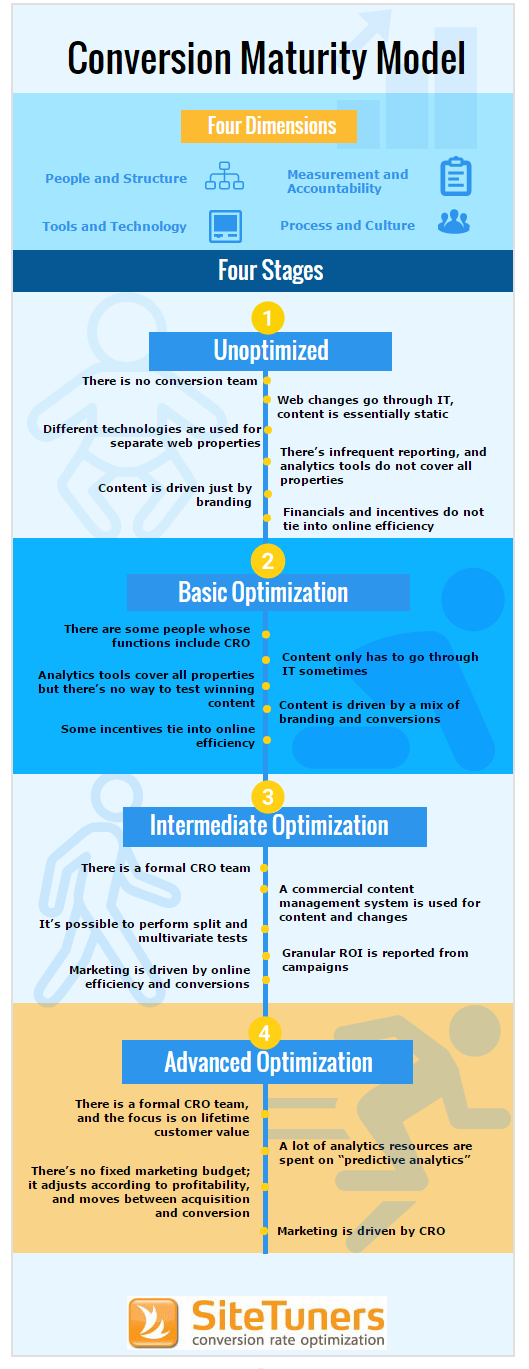
Recognizing the importance of conversion rate optimization (CRO) and effectively utilizing optimization resources are two different things, though. It is, however, relatively easy to tell how CRO-mature your company is.
Check out the Conversion Maturity Model to identify where you are on the roadmap and, more importantly, what you need to do to take conversion rate optimization to the next level.
Caveat: Not all dimensions will be at the same stage. You could, for instance, be intermediate in tools and technology, but unoptimized in process and culture.
Here’s a description of those dimensions in each stage:
People and Structure: Getting a seat at the grown-up table
Unoptimized
- There are no full-time formal positions devoted to conversion rate optimization.
- Employees have no training of any kind in CRO.
- Conversion rate optimization is not on the organizational chart.
- Marketing focus is on traffic acquisition volumes.
- Most website changes need assistance and approval from IT.
Basic
- Some full-time non-management positions are devoted to CRO within certain departments.
- Conversion rate optimization is done at an individual level, instead of as a team.
- A few additional employees have some informal training in CRO.
- Marketing focus is on profitable traffic acquisition.
- Basic website content changes can be made without IT involvement.
- Static content on your site is now under your control. You only need IT involvement if you’re changing an entire flow, your information architecture, or something with forms in it.
- Some landing pages and microsites are under the control of online marketing.
- Main site design, messaging, and structure are still largely under the control of brand/ marketing (with support from IT).
Intermediate
- There is a formal CRO team with full-time positions and a manager within a specific department (not strategic).
- This is not yet a higher-level, executive position in a larger company.
- CRO team members have periodic formal training in CRO and are given the opportunity to get additional informal training.
- The company sends more people to live events to learn and network with peers.
- Conversion rate optimization team periodically conducts informal training for a wider internal audience.
- You’re spreading the knowledge within the company and socializing the results of testing.
- Marketing focus is on profitable traffic acquisition and conversion.
- This is a big mindset change because it’s typically binary – people either care about traffic or about conversion.
- Website content and many structural (page-flow) and functionality changes can be made without IT involvement.
- All landing pages and microsites are under the control of online marketing.
- Some parts of the main website are under the control of online marketing.
Advanced
- There is a formal stand-alone CRO team with full-time positions and a manager which reports to the CMO (or higher).
- Conversion rate optimization team sets strategic priorities company-wide via a formal intake process.
- People come to you to do their project, to fix their part of the website, etc. And you’re prioritizing projects based on what’s going to have the highest possible impact on the business.
- CRO team members have regular formal training in conversion optimization.
- CRO team regularly conducts informal training for a wider internal audience.
- Marketing focus is on increasing profits over the lifetime value of the customer.
- You can’t improve the lifetime value of the client relationship, if you can’t measure it. This means you become a business analyst and dig at the underlying economics of the business to understand what turning certain knobs on the front-end of the site experience ultimately does to your bottom line.
- This is how you get a seat at the grown-up table. The C-suite only speaks one language: money (i.e. how much money was made, the potential impact of an activity). You could present a model to show what percentages of phone calls or form fills go to paid trial, what percentages of those the sales team upsells into clients, and how long those clients stay with you.
- Almost all website content and structural changes can be made without IT involvement.
- Cycle time wins. It’s problematic when there’s somebody in the middle of the process, so the goal is to remove the need for IT assistance in the testing process. IT’s job should only be to make sure the site doesn’t go down and that pages load quickly.
- Most parts of the main website are under the control of online marketing.
Tools and Technology: Having the right tools to go faster
Unoptimized
- Websites are mostly static content.
- The company uses proprietary content management systems (CMS).
- These are are difficult to maintain. Unless the best use of your company is to create custom CMS, you’d want to be in a commercial one.
- Different technology platforms exist across divisions.
- For example, your blog is on WordPress but the rest of your site is on a different CMS.
- Few qualitative or quantitative diagnostic tools are used anywhere to uncover conversion issues
- You might use them once in a while to diagnose specific issues, but you don’t use them everywhere.
- When diagnostic tools are available, they are not applied consistently.
- You tend to use them on a project by project basis.
Basic
- Websites are mostly in commercial content management systems.
- There are more standardized technology platforms across divisions
- No qualitative or quantitative diagnostic tools are used company-wide.
- Your focus shouldn’t just be on quantitative tools. A lot of times, the best insights you’re going to get are qualitative (e.g. insights you get from listening to a user testing session of somebody trying to do a key task on your site). You can’t answer the ‘why’ question or the conceptual problems that people have with quantitative tools.
- Split testing tools are used opportunistically by small teams.
- It’s not a formal process yet. You don’t have a queue of things to fit in to the testing schedule.
- Very basic segmentation and analysis is done on test results (e.g. weekends versus weekdays, Google versus your affiliate channels, etc.)
- There is no easy way to update web content with test-winning content.
- There’s no formal process for rolling content live on your site. If you get a great win, the test results go into the IT queue and might only get deployed live on your site after 6 months, so you don’t get the benefit of it during that time.
- Website changes are frequently made without measuring their impact.
- Website redesigns are led by branding and marketing (without a deep diagnostic phase focused on visitor needs).
Intermediate
- All websites are in commercial content management systems.
- Technology platforms are standardized across divisions.
- Some qualitative and quantitative diagnostic tools are used company-wide.
- Split and multivariate testing tools are used routinely by small teams.
- Some split tests are segmented by traffic source or other single parameters (e.g. time of day, day of week)
- You might be serving up results differently based on those things.
- Marketing automation systems and customer relationship management systems (CRM) are in place but are not integrated into the testing.
- This is critical. The only way you can identify a returning customer or a prospect and whether you should serve them a different experience is to hit your CRM in real-time and pull that information. Otherwise, you’re working on averages, and that’s a problem. If you can put it to the individual level, you’re way ahead of the game.
- Some longer-term prospect and client behaviors (e.g. trial completion, re-subscription rates, client surveys and research studies, and lifetime value estimates) are provided to CRO team upon request by other departments.
- You’re getting all of the lifetime value and the downstream information that’s happening beyond the website.
Advanced
- All websites are in commercial content management systems and integrated with CRM, marketing automation, and traffic acquisition,
- You’re changing your bids in real time based on time of day, day of week, and traffic sources, for instance.
- Technology platforms are standardized across divisions.
- Wide variety of qualitative and quantitative diagnostic tools are used company-wide.
- Split and multivariate testing tools are used routinely company-wide.
- Real-time content changes are made on individual visitor basis using predictive analytics, behavioral targeting, and lead scoring.
- The ability to change content on the fly to the individual level is what separates advanced from intermediate organizations. When you hyper target people, that’s when you’ll see a 500% to 1000% increase in conversions.
- You’re doing real-time data append to learn about a visitor. If you’re consumer-facing business, you can, say, append 60 data points to any consumer that visits your site (e.g. demographics, psychographics, etc.) And you can change the site behavior in real time.
- Companies like Commerce Sciences or Evergage can overlay on top of your CMS and change things on the fly.
- Winning versions of tests are automatically deployed (and back-tested on a continual basis to ensure sustainable improvements).
- Don’t think of tests as discrete events. Back test and keep a small percentage of your traffic running through your testing system to make sure you don’t find some behavior changes over time. Keep an eye on this because there’s seasonality and changes in people’s long-term behavior.
- It’s not a matter of testing new ideas – some of your old ideas might be the right answer, so keep them in the mix.
- All web-facing experiences are easily reconfigurable and can be rapidly tested.
Measurement & Accountability: Tracking the right metrics & reacting quickly
Unoptimized
- Reporting of key metrics involves manual work and is infrequent.
- Web analytics does not cover all web properties & campaigns.
- Campaign-level or more granular ROI is not tracked or measured.
- Marketing budgets are fixed (regardless of outcomes or profitability).
- There is no culture of measurement within the company.
- Marketing decisions are frequently overruled by executives without a quantitative basis.
- A lot of website changes are still made based on the HiPPO (Highest Paid Person’s Opinion).
Basic
- Reporting of key metrics is done via near-real-time dashboards.
- You can also pull together dashboards from different data sources including Google Analytics, your CRM, etc. using tools like Cyfe.
- Web analytics covers all web properties and campaigns.
- Campaign-level or more granular ROI is often measured.
- Marketing budgets are fixed at regular intervals (based on past ROI of similar activities).
- There is a culture of measurement within web analytics and traffic acquisition teams.
- There is little culture of measurement in branding, creative, operating divisions, or offline marketing.
Intermediate
- Reporting of key metrics is done via near-real-time dashboards.
- Automatic alerts are triggered if key metrics are out of line.
- Web analytics covers all web properties and campaigns, and is combined with a strong business intelligence team that all departments and operating divisions have access to.
- Campaign-level and more granular ROI is always measured.
- Marketing budgets are flexible and may be periodically reprioritized depending on the current mix and profitability of acquisition activities.
- There is a culture of measurement within web analytics and traffic acquisition teams and the operating divisions.
- There is some culture of measurement in the branding and creative departments (and changes often require quantitative proof).
Advanced
- Reporting of key metrics is done via near-real-time dashboards.
- Automatic alerts and corrective actions are automatically triggered if key metrics are out of line.
- There is an understanding and tolerance for negative test outcomes.
- Web analytics team main focus is developing predictive analytics models and deploying them in the form of website business rules and triggers to change the site experience on an individual basis.
- There are no fixed marketing budgets and spending is quickly reprioritized depending on the current mix and profitability of acquisition activities.
- There is a culture of measurement within all departments and operating divisions of the company.
Get immediately notified of red flags on your website.
Click here to read 6 Great Google Analytics Alerts: Less Time Panicking, More Time Solving Issues.
Process and Culture: Being agents of change
Unoptimized
- There are no formal processes for CRO.
- Marketing is driven by branding and creative campaigns.
- Redesigns are not done out of wanting to meet visitor intent better or to create a better user experience.
- Financial rewards are not tied to improvements in online efficiencies.
- There is no executive management awareness of CRO.
- Positioning, messaging, product offerings are largely defined by brand/ marketing.
- Offline and broadcast content and messaging is reused without changes for the web.
Basic
- There are formal processes for tactical split testing.
- Marketing is driven by a mix of creative campaigns and high-impact CRO activities.
- Some teams or operating divisions have compensation tied partially to improvements in online efficiencies.
- There is some executive management awareness of CRO, but not much active support (championing of projects or initiatives).
- There are turf issues between accountability-driven teams and brand/marketing.
Intermediate
- There are formal processes for tactical split testing and implementing permanent changes based on winning test versions.
- Marketing is driven mostly by high-impact CRO activities.
- All operating divisions have compensation tied to improvements in online efficiencies.
- There is a broad executive management awareness of CRO, and some active support for projects or initiatives that are on a long-term roadmap created by executive management.
- Web visitor behavior and the results of CRO activities are informally fed back to marketing to revise value propositions and product offerings.
Advanced
- There are ongoing and largely automated processes for tactical split testing and implementing permanent changes based on winning test versions.
- Marketing is driven exclusively by high-impact CRO activities which are prioritized via a structured submission and evaluation process.
- All operating divisions have compensation tied to improvements in online efficiencies.
- There is universal executive management awareness of CRO, and active support for all projects initiated by the CRO group
- There is solid cooperation among all departments
- In other words, IT, marketing, branding, CRO, web analytic, etc. all get along.
- Web visitor behavior and the results of CRO activities are actively and systematically fed back to marketing to create new value propositions and product offerings
Raising Your Conversion Rate Optimization Game
A culture tied around conversion rate optimization needs a lot of work. You typically cannot move from having an unoptimized presence to having advanced CRO practices.
To up your CRO game, you’ll generally need …
- Dedication – Some people in your organization must have CRO as their only job, and have higher-level support.
- Honesty – Problems and shortcomings should be addressed directly and openly.
- Focus – Well-defined business goals should be set, executed, tracked, and incentivized.
- Flexibility – Everything should be quickly changed when necessary: business models, branding, allocated resources, and tools.



